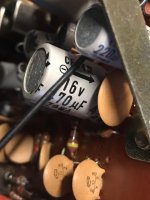Servicing an electrolytic capacitor in-circuit? I always unsolder it and measure if I suspect a capacity loss. In a PSU you can measure ripple voltage on them.
In my experience, these do drop in capacity, but the overall circuits are really robust, so unless the device misbehaves, I would not touch them. Those phenolic PCBs are easily damaged, so why take the risk. If it's 470u, it's likely a smoothing cap, and probably would not matter if it is only 200u by now.
(Recently "upgraded" my 35+ radio clock with new tactile switches, only to discover one completely popped cap and another one leaking all over. No issues there, but replaced all 3 caps anyway...)
(Recently "upgraded" my 35+ radio clock with new tactile switches, only to discover one completely popped cap and another one leaking all over. No issues there, but replaced all 3 caps anyway...)
Thanks for the replies, I think I'll stick with them for now. I've brought it up slowly and it's working as expected.
Such ones are seen often in measurement devices made in Japan. Often they have suffered from age and have diminished in value (but certainly not always). If the sleeves have shrunk because of local heat then be sure to replace them. Usually the filter caps after rectifiers and/or near transistors/regulators are the worst. There are differences depending on brand and series but in general caps used to be OK then but their age does not make them better. Can't be specific about Towa because I usually just yank them out and replace them just to be sure things keep working. Continuity preferred over stuff being "original".
Doing nothing and not measuring them (so choosing not to know anything) is an option but make sure the semis are in stock in case the caps decide to break down.
* make sure to have the transformers voltage set closest to todays local mains voltage. Old equipment usually had both 220 and 240V taps.
Doing nothing and not measuring them (so choosing not to know anything) is an option but make sure the semis are in stock in case the caps decide to break down.
* make sure to have the transformers voltage set closest to todays local mains voltage. Old equipment usually had both 220 and 240V taps.
Last edited:
50 years is a bit much for electrolytics IMO. But then again if its not misbehaving its safer not to upset the board. You need to pull them (at least one pin) really to measure things like ESR and leakage.
